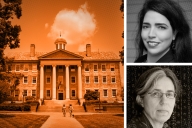You have /5 articles left.
Sign up for a free account or log in.
While there’s a lot of chatter and pessimism about how the Great Recession changed the nature of states’ relationships with their higher education institutions, this year’s Grapevine survey of state appropriations hints that the new normal might be more normal than new.
State revenues and appropriations to higher education tend to lag after a crisis, but right on cue they seem to be showing modest stabilization and improvement, just like the national economy.
The Grapevine report, produced by the Center for the Study of Education Policy at Illinois State University and the State Higher Education Executive Officers, shows that state appropriations on higher education increased in 31 states for the 2013 fiscal year. While the overall trend was a decrease of 0.4 percent, that is a sizable difference from last year’s 7.5 percent decline.
If California -- which makes up 12 percent of all state higher education spending -- is taken out of the picture, the overall trend is a slight increase in state appropriations to higher education.
The gains are small, with most states seeing increases of less than 5 percent, and most are still well below where they were five years ago, particularly when one factors in enrollment increases, which spiked during the economic downturn. But the report’s authors and other higher education finance observers say this year’s report hints at a turnaround in the general funding picture.
“Historically there have been ups and downs in state funding. The Great Recession created a huge trough, but barring further or unexpected declines, I think we’re beginning to climb out of the trough, at least at a national level,” said James C. Palmer, professor of higher education at Illinois State University and director of the center.
Paul E. Lingenfelter, president of the State Higher Education Executive Officers, said the report is not necessarily reason for optimism, but it is a reason not to be so pessimistic, either. “You could call this stabilization but not recovery,” he said.
The report’s findings seem to underscore the outsize role that economic factors play in higher education funding, despite all the discussion about changing state political dynamics.
“Based on recent trends, you often hear sweeping generalizations that are pessimistic about public higher education. That’s probably unwarranted,” Lingenfelter said. “There’s a weak economy and that’s driving substantial tuition increases. Once those issues settle down, you start to see people recognized the fundamental value and importance of higher education.”
A recent report by the think tank Demos found that economic factors, more than political and cultural factors, played the largest role in determining a state's investment in higher education. "Better funding opportunities are available in states with stronger economies," the report states.
Over the past few years, states such as North Dakota and Wyoming, which have thrived in the downturn but have small government, anti-spending political cultures, have tried to invest in higher education institutions when they have budget surpluses. “States still want strong higher education systems,” Palmer said. “Legislators want their citizens to have the opportunity to get a college education.”
In recent weeks, several governors from across the political spectrum – including California’s Jerry Brown, Colorado’s John Hickenlooper, Nebraska’s Dave Heineman and Nevada’s Brian Sandoval – have proposed increasing appropriations to higher education, citing promising revenue outlooks.
While the overall trend is stabilization, the report’s authors noted that there is wide divergence in how individual states are faring, though not as much as in the past. Last year there was a 53 percentage point gap between the state with the largest increase (Illinois, with a 12.1 percent increase) and the one with the largest decrease (New Hampshire, which saw a 41.3 percent decline). This year that gap is only about 27 percentage points (Rhode Island with a 13.5 percent decline and Wyoming with a 13.7 percent increase).
States with a large part of their pre-recession economy tied up in housing, including Arizona, Nevada, Florida and California, are still struggling and facing annual declines.
States such as Wyoming and North Dakota are seeing large increases driven by natural resource booms. Those states, two of the smallest in the country in terms of population, were also not greatly affected by the economic downturn.
State appropriations did not make up as large a portion of the budgets of New Hampshire’s public higher education institutions even before 2008, so the declines, which stand out as some of the largest, percentage-wise, over the past five years, don’t have as significant an effect as those in other states, such as California, where state funding historically made up a large component of colleges and universities’ budgets.
Most of the increases in appropriations in Illinois have gone toward backfilling the state’s underfunded pension programs.
Officials said that while there is reason to be optimistic, it could be a long time before many states start to see robust increases. The economy might not be in recession, but its growth is anemic, and uncertainty at the federal level could quickly dampen recovery. States still face structural spending problems, such as underfunded pensions, rising health-care costs and corrections, which tend to take precedence over higher education.
“Given all of the economic indicators, no one should be under the illusion that this swing in higher education funding somehow marks the start of a new upward trajectory,” said Daniel Hurley, director of state relations and policy analysis for the American Association of State Colleges and Universities. “I think there’s reason to be optimistic that we’ll see improvement in the near future, but that growth is likely to be modest.”








